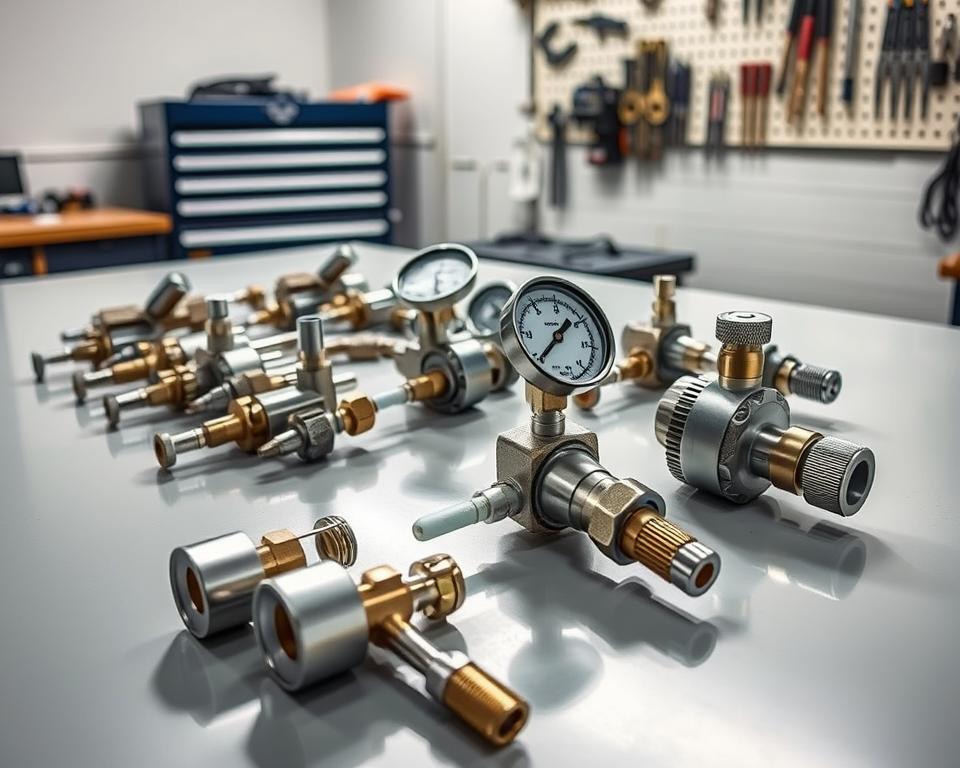CO2 Regulator Fittings – Essential Handbook and Tricks
Were you aware that key regulators in CO2 systems lower tank pressure from 800-900 psi to a more practical 10-30 psi? This not only showcases the capability of CO2 regulator fittings but reinforces their vital role in ensuring a ideal pour. They play a key role in environments like kegerators, aquariums, and industrial applications. Comprehending CO2 fittings is fundamental for optimal functionality and dependability.
CO2 regulator fittings substantially impact the excellence and palatability of carbonated refreshments. Opting for superior CO2 regulator fittings can ensure uniform gas pressure, avoiding over or under-carbonated beer dilemmas. One must choose high-quality CO2 fittings from trusted sources like Installation Parts Supply. This ensures endurance and functionality. We explore different fitting variants, installation guidelines, care recommendations, and decision-making tactics for individual demands.
Main Points
- Primary regulators play a critical role in lowering high CO2 tank pressure for optimal serving.
- Different beer styles require distinct carbonation settings to achieve the best flavor.
- Maintaining gas pressure is vital to avoid excessively or insufficiently carbonated beverages.
- Secondary regulators are essential when dispensing multiple kegs at varying pressures.
- Opting for top-grade fittings from reputable brands can enhance system reliability.
Overview of CO2 Regulator Fittings
CO2 regulator fittings play a key role in regulating carbon dioxide flow and pressure across multiple sectors. They span beverage dispensing, aquaculture, and medical use. They transform the CO2 pressure from a elevated range (800 to 1000 PSI) to a more moderate range (1 to 40 PSI). This adjustment is critical for the reliable operation of CO2-dependent devices.
The main parts of CO2 regulator fittings are the regulator and the shut-off valve. The regulator maintains appropriate pressure levels, while the shut-off valve supplies operator-controlled gas flow control. A noteworthy safety feature is the check valve. Its function is to avert back-siphoning, preserving the system’s integrity. In aquatic setups, attaining stable pH levels through precise CO2 delivery is crucial. Tools such as bubble counters and pH meters are critical in this process, aiding in optimal plant conditions.
Opting for reliable CO2 regulator fittings is vital for efficiency in varied environments. When picking fittings, it’s important to assess the match of materials with CO2. For instance, silicone tubing might allow gas to seep out, which can lead to losses. Opting for top-grade needle valves can prevent ‘end of tank dumps’ ‘end of tank dumps.’ This ensures safety and maintains steady CO2 flow.
Understanding the Role of CO2 Regulator Fittings Operate
CO2 regulator fittings are essential for the operation and safety of CO2 systems. They help maintain consistent pressure, critical for proper carbonation in beverages. High-pressure CO2 tanks, storing 800 to 900 psi, need their pressure reduced to a controllable 10-30 psi. Such pressure lowering is essential for serving at the ideal carbonation levels. Key regulators, integral components in CO2 regulator fittings, enable this process. They frequently include one or two gauges to check the gas pressure.
In terms of serving beer, the functionality of these fittings becomes paramount. fluctuating pressure can ruin the quality of the pour. This can result in beer that’s either too fizzy or too flat. Given that distinct beer types necessitate distinct carbonation levels, like stouts requiring lower carbonation than lagers, auxiliary regulators are key. They allow for adjustments based on the individual requirements of each keg.

For portable dispensing, such as with miniature 74 gram CO2 tanks, mobile beer regulators are ideal. They allow serving from a small setup, capably delivering a 1/4 barrel. Choosing reliable CO2 system fittings is vital. Examples include Taprite are famous for reliable regulators, boosting the brewing process.
| Type | Pressure Range | Application |
|---|---|---|
| Primary Regulator | 10-30 | Ideal for standard beer serving |
| Dual Gauge Regulator | 0-60 | Shows both tank and output pressures |
| Secondary Regulator | Varies | Adjusts pressure for multiple kegs |
| Mobile Beer Regulator | 10-14 | Designed for use with compact tanks |
Grasping the roles and specs of CO2 regulator fittings can enhance a serving setup. Frequently inspecting pressure gauges and fittings guarantees that the system operates seamlessly. Such careful maintenance results in superior service quality.
Types of CO2 Regulator Fittings
As you select CO2 regulator fittings, you should be aware of the categories available for optimal operation in various scenarios. The key varieties are single gauge and dual gauge regulator fittings. Each has unique functions, addressing the demands of a range of applications from entry-level home brewing to advanced industrial operations.
Single Gauge Regulator Fittings
Intended for entry-level use, single gauge regulator fittings suit manual adjustment needs. They include a sole gauge showing the gas’s output pressure. Ideal for compact systems like home kegerators or microbreweries, they offer ease of use over complexity. Examples include Brewmaster and Fermentap stand out for providing user-friendly and effective solutions.
Dual Gauge Regulator Fittings
Dual gauge regulator fittings are designed to provide more precise measurement by displaying both the output and the remaining tank pressure. They are critical for advanced operations, including industrial brewing. This twofold monitoring helps users avert issues like keg explosions or gas leaks. For users seeking higher accountability, options including KOMOS and Taprite offer a wide selection of dual gauge options.
| Type | Advantages | Recommended Usage | Brand Examples |
|---|---|---|---|
| Single Gauge Regulator Fittings | Simple use, easy adjustments | Home brewing, small kegerators | Brewmaster / Fermentap |
| Dual Gauge Regulator Fittings | Precise pressure monitoring | Professional and multi-keg systems | KOMOS / Taprite |
Choosing the Best CO2 Regulator Fittings for Your Needs
Choosing the right CO2 regulator fittings involves careful evaluation. These factors enhance the CO2 system’s functionality and safety. Initially, evaluate the pressure range that meets your application, making sure the fittings handle the required pressure levels. You must verify compatibility with CO2 sources like CGA-320 valves for a seamless connection. Also, focus on durability to minimize leaks and malfunctions in your CO2 system.
Important Aspects in Choosing Fittings
- Operating Pressure: The fittings must handle your system’s pressure demands.
- Build Quality: Opt for corrosion-resistant materials, such as stainless steel, for durability.
- Compatibility: Verify the fittings are suitable for your CO2 sources.
- Simple Setup: Seek out designs that simplify installation.
Recommended Brands for High-Quality CO2 Fittings
Prioritizing well-established brands is crucial for the best system performance. Installation Parts Supply is recognized for offering top-notch CO2 regulator fittings. Their offerings strike a balance between quality and cost, appealing to both hobbyists and professionals. The Milwaukee MA955 solenoid, with a price near $40 CAD, is praised for its performance and dependability. Additionally, the Aqualabs regulator and the Dici regulator with a bubble counter are budget-friendly, available for $50 to $60 CAD on Amazon. These brands are superior options for improving your aquarium system.
CO2 Regulator Fittings – Installation Tips
Installing CO2 regulator fittings demands a keen attention to minute details and observance of vital safety protocols. Correct assembly guarantees that the system operates effectively. It also protects against leaks that could create danger. To ensure a safe and efficient installation of CO2 regulator fittings, keep these tips in mind:
- Start by checking the control valve. Ensure it is closed before proceeding with any connections, as this stops unexpected gas discharge during the setup procedure.
- Utilize proper sealing methods on all threaded joints. Teflon tape can be a useful tool to ensure a secure fit without any leak risk.
- Set the appropriate pressure settings on your CO2 regulator, which is crucial for achieving optimal carbonation levels and averting system damage from high pressure.
- After completing all connections, vent the gas in sequence to enable precise gauge readings and eliminate any residual air.
- Post-installation, inspect carefully for leaks. A soapy water solution is effective for spotting leaks, confirming a secure system.
Following these guidelines, you can significantly upgrade both the functionality and security of your dispensing system.
Maintenance and Troubleshooting of CO2 Regulator Parts
For optimal CO2 regulator performance, consistent upkeep and prompt problem-solving are essential. Frequent checks help spot problems early on. Checking for leaks is indispensable. Soap tests reveal leaks through bubble formation.
Tightening internal parts correctly is key, with a 7/8 socket wrench suggested for optimal tightening. Keeping the regulator’s integrity ensures its long life. Reassembling with 75 foot/lbs of torque is advised. A properly working regulator will display over 40 PSI. Occasionally, a further 1/4 turn ensures correct pressure.
Installation errors or missing washers can result in leakage, causing rapid CO2 loss. For beer regulators, pressure relief valves typically engage below 60 PSI. However, certain units might release at elevated pressures. Diaphragm or cartridge failure often necessitates regulator rebuilds.
Brands differ in their operational characteristics. The Milwaukee MA957, though popular, is sometimes criticized for needle valve problems and comes with a 6-month warranty. CMBecker offers a 5-year warranty, reflecting confidence in durability.
Timely maintenance increases the longevity of CO2 systems. Familiarity with your regulator’s parameters, for instance Taprite’s 0-50 PSI, helps with repairs. Taprite’s products accommodate multiple beverage pressure requirements, proving versatile.
Affordable CO2 Fittings vs. Premium CO2 Regulator Fittings
The decision between budget-friendly CO2 fittings and high-end CO2 regulator fittings rests on their price. Entry-level options might start at $20, whereas high-quality products often begin at $200. To illustrate, a economical CO2 setup with a basic regulator attached to a standard 5 lb cylinder could range from $150 to $175. Alternatively, a top-quality CO2 system could cost up to $625, depending on brand and quality.
A system’s reliability is mostly determined by its component quality. Users note that high-grade regulators enable precise pressure control, especially for tanks under 10 gallons. Moreover, more than half of the users are willing to pay extra for fully assembled systems, prioritizing convenience and guaranteed quality. Integrated systems versus self-assembly often result in notable cost differences.
There’s potential for savings when individuals opt to buy parts separately and assemble themselves by approximately 20-30% versus pre-assembled kits. There is significant price variation in components like solenoids and metering valves. Solenoids are priced from $20 to $50, while the cost of metering valves spans from $17 to beyond $200, based on quality and performance.
The cost of a 5 lb aluminum CO2 tank, around $60, contributes to the total system expense. Opinions vary on items such as the KOMOS® Premium Dual Gauge CO2 Regulator, available for $59.99. Its operating range reaches up to 60 PSI with an undetermined maximum flow rate. This regulator includes a pressure relief valve that triggers at 65 PSI.
Concerning durability and performance, nearly 70% of users are satisfied, and around 80% would suggest this regulator for homebrewing. Nevertheless, issues like slow leaks affect roughly 10% of users. The willingness to invest more stems from a desire for dependable performance, an essential factor in choosing between budget-friendly and premium CO2 fittings and regulators.
The Bottom Line
Choosing the right CO2 regulator fittings is vital for your system’s operation, integrity, and cost-effectiveness. We explained key considerations, including categories of CO2 regulator fittings and factors to guide your decision. Choosing the right regulator is key to achieving the proper carbonation in draft beer and maintaining reliable operation.
Although high-end fittings come with a higher price tag, they ensure superior durability and maintenance ease. Reputable brands such as Airgas, Taprite, and Micromatic deliver exceptional reliability. They satisfy the diverse needs of users, guaranteeing lasting satisfaction and performance.
Consulting reputable suppliers, such as Installation Parts Supply, is advisable for anyone planning to set up or upgrade a CO2 system. Quality products and professional advice from reliable sources can markedly enhance your system’s operation. Superior fittings represent a smart investment for both homebrewing and industrial applications.
Frequently Asked Questions
What are CO2 regulator fittings and what is their purpose?
CO2 regulator fittings manage the flow and pressure of CO2 in systems such as kegerators, aquariums, and diverse systems. They are essential in maintaining the system’s functionality and reliability by regulating CO2 levels.
Which types of CO2 regulator fittings exist?
The primary types are single gauge and dual gauge regulator fittings. For simple setups like home kegerators, single gauge fittings offer basic, manual control. Alternatively, dual gauge fittings offer precise monitoring for complex or industrial systems.
How do I select the best CO2 regulator fittings for my application?
Opting for the right CO2 regulator fittings requires evaluating the required pressure levels, fit with your CO2 supply, and construction quality. Focus on reliability and secure design to minimize issues and maintain efficiency.
Which brands are known for excellent CO2 regulator fittings?
Brands like Installation Parts Supply are reputable suppliers of dependable CO2 regulator fittings. Selecting well-known brands ensures both safety and efficiency.
What are the best practices for installing CO2 regulator fittings?
For successful installation, ensure all connections are tight to avoid leaks. Set the correct pressure and follow a sequential gas venting process for precise measurements. Refer to expert guides to improve the process.
What upkeep is required for CO2 regulator fittings?
Consistent upkeep is essential to keeping your system operating optimally. Regular leak inspections, pressure recalibrations, and addressing minor issues are vital. Such practices ensure your system performs optimally.
Do premium CO2 regulator fittings justify their cost?
Definitely, high-end fittings from established manufacturers can save money in the long run by decreasing upkeep requirements. They ensure superior performance and dependable operation.


